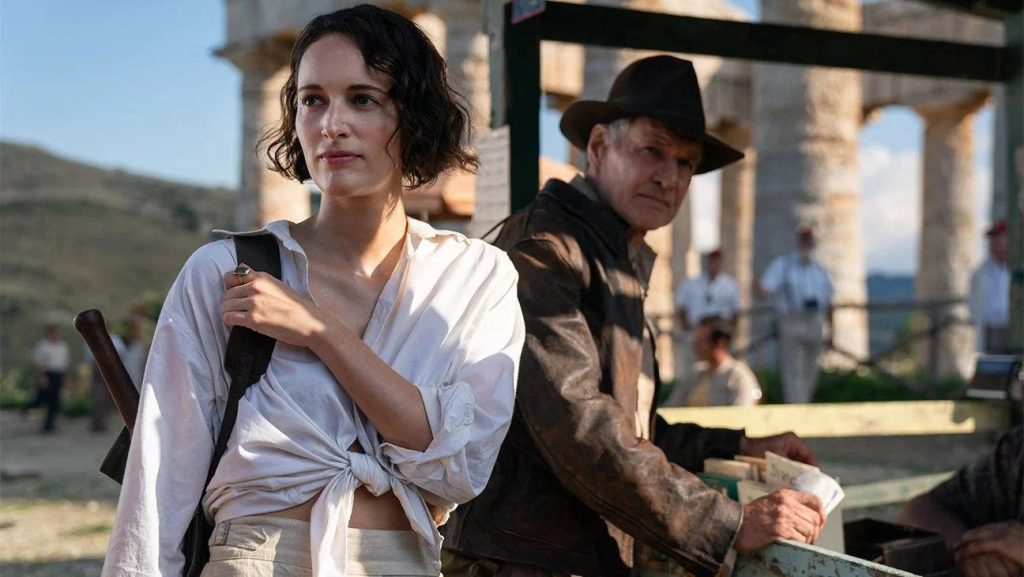As I collected my thoughts about James Mangold’s long-awaited Indiana Jones finale in preparation for writing this review, I kept coming back to a single, deceptively easy question: what separates Dial from Top Gun Maverick, another long-delayed sequel to an ‘80s classic featuring the original star? The obvious answer is, of course, success. Maverick roared past pandemic-era expectations to a $1.5 billion gross and strong critical acclaim. Dial, on the other hand, underperformed in its opening weekend and was humiliatingly dethroned domestically by the new Insidious movie the next. Critics’ reviews have also been mixed, with nearly all of them comparing the film unfavourably (and sometimes unfairly) to the illustrious original. What was supposed to be a last hurrah in which the iconic adventurer returns to his Nazi-fighting, relic-chasing glory days ended up as a hugely embarrassing misfire.
This is a purely superficial perspective, though. The gulf between the two blockbusters, similar though they might appear on paper, is actually even wider. It’s the same thing that separates a Terminator Genisys from a Jurassic World or a The Avengers (that one, not that one) from a Casino Royale: both films successfully honour the legacy of their classic antecedents, but while Maverick relentlessly improves upon the original with action sequences that set new standards for the genre, Dial fails to create anything new and memorable beyond that. Whereas Maverick would still be top-notch if stripped of the Top Gun name, without the rich well of Indiana Jones to mine, Dial would quite literally be nothing. The mere fact that barely a week on from seeing the film, I struggle to remember the name of one of its main characters (Phoebe Waller-Bridge’s entirely unnecessary child sidekick) already speaks volumes.
It’s Teddy, apparently. Thanks, IMDb.

This isn’t really about character, though; even Roger Ebert, a huge fan of the series, admitted that Raiders of the Lost Ark features “personalities so shallow they’re like a dew that has settled on the characters.” Indiana Jones has never been a nuanced character study, nor has that ever been the intention. All the humanity in the films comes directly from their star, the unfailingly authentic Harrison Ford, and the rich gallery of veteran character actors surrounding him: John Rhys-Davies, Denholm Elliot, Paul Freeman, and Amrish Puri, to name a few. What truly animates the franchise is action, in the most basic sense: the first three movies are always moving, always showing us some crazy new stunt, some repellent new horror, some breathtaking new locale. They may sometimes be goofy or even outright insensitive, but one thing they never are is boring (yes, that goes for Crystal Skull, too, fridge-nuking and all).
My issue with Dial, at heart, is that its action, which should be the core of the experience, feels like an afterthought. Sure, there’s plenty of it, but it’s never particularly inspired. In fact, it often seems worryingly like a pastiche of the earlier films: a motorcycle chase with Nazis from Last Crusade, a creepy crawly-filled corridor from Temple of Doom, and so on. The opening—which takes us back to Indy’s WWII heyday with mostly fine de-aging—is promising, but as soon as the present-day plotline lurches into action, it begins to disappoint. That chase sequence with the horse in the subway that’s in all the trailers turns out to be exactly what it was sold as—a standard setpiece with a gimmicky twist that adds nothing and never builds to anything. Hell, John Wick did it better.

The rest of the film blurs together into various other chases, gunfights, and archaeological puzzle-solving that hardly seems novel enough for an Uncharted sidequest. Now that the pulp adventure tropes that Indy redefined have become ubiquitous, the least Dial could do is offer a superior, refreshing take on them. Instead, it feels like a copy of works that owe their existence to Indiana Jones in the first place—in that case, what point is there to this film’s existence, exactly? More often than not, Dial can’t seem to answer that question in any satisfying way, making for a generally frustrating viewing experience. Even the surefire nostalgia elements—the John Williams theme, the hat, Ford himself—are deployed so bafflingly, repeatedly pushing for cheers at the most anticlimactic moments, that they lose whatever emotional charge they might have had.
To the film’s credit, it does pull out a genuine surprise in its third act, taking Indy somewhere he has never been before. Without spoiling anything, I can say most of the home stretch is well-executed and true to the character and his storied history. But, by then, it’s too little, too late. This should have been a grand finale, a celebration of all the phenomenal entertainment Indy has brought to the silver screen since 1981. Yet it fails to perceive that formula and empty call-backs won’t do the trick; true to the character’s catchphrase, “I’m making this up as I go along,” the films’ success relies on constant invention and innovation. By being merely unmemorably ‘good enough,’ Dial betrays the spirit of Indiana Jones. The series, and its legendary star, deserved better. And, with films like Maverick or Spider-Man: Across the Spider-Verse out there that instill beloved IP with vibrant new life, its shortcomings become more apparent than ever.
